What's New
Displaying results 3621 - 3630 of 4052
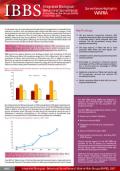
Resource | Fact Sheets,
In Indonesia, men who have assumed a female identity (transgenders or transvestites) are referred to as Waria. Prior surveillance data indicate that Waria tends to engage in risky sexual behaviors, and have high HIV prevalence. This summary presents key findings of the IBBS 2007 for Waria from five (5) cities (Jakarta, Bandung, Semarang, Surabaya, and Malang). Behavioral data were gathered in all five cities, while biological data were gathered in three cities (Jakarta, Bandung, and Surabaya).

Resource | Publications,
The first NBSS on HIV/AIDS 2007, a large population-based survey, obtained statistics on awareness, attitudes, and perceptions about HIV/AIDS and sexual practices among Singaporeans.
The survey is self-administered using the Audio Computer-Assisted Self-Interviewing (ACASI) tool that was developed specifically to gather information on sensitive topics such as HIV/AIDS. It provides an extra measure of privacy as, through using ACASI, the survey can be done in the absence of an interviewer.
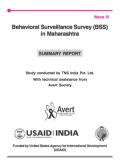
Resource | Publications,
The purpose of the Behavioral Surveillance Survey (BSS) is to systematically monitor trends in HIV / STI risk behavior over time. Thus, it is imperative to conduct BSS at certain periodicity to track the behavior change systematically.
The BSS wave III covered the same seven districts (viz., Mumbai, Thane, Sangli, Solapur, Satara, Aurangabad, and Nagpur), which were included in the previous wave. The wave III covers three new groups in addition to the groups covered in the wave II namely: unmarried female college students, unmarried female slum youth aged 15-19 years, and unmarried female slum youth aged 20-24 years.
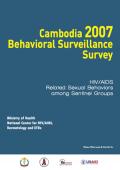
Resource | Publications,
Behavioral Sentinel Surveys have been carried out by the National AIDS Program (NAP, now known as NCHADS) in five provinces (Kampong Cham, Sihanoukville, Battambang, Siem Reap and Phnom Penh) since 1997. The first year served to supply baseline data, and in subsequent years, the progression of these variables has been monitored.
This publication presents the result of the seventh round of Behavioural Sentinel Survey, which was conducted in 2007. Female (brothel-based female sex workers, beer promoters, karaoke workers, and beer garden workers) and male (moto-taxi drivers) and MSM (short and long hair) were included in this round.
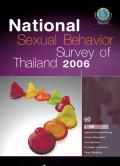
Resource | Publications,
The overall objective of this study is to gather information for use in planning and evaluation of the national AIDS program and related policies.
In the process, a substantial number of the indicators needed by the national program and the international community, are collected and reported based on a nationally representative sample.
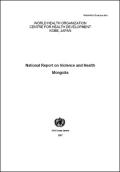
Resource | Publications,
Despite the numerous activities being carried out by the Health Ministry of Mongolia with the assistance of WHO, the National Traumatology and Orthopedic Teaching Hospital (NTOTH) and many other international institutions, it is clear that the statistics of violence, traffic and household injury show a trend to growth rather than decline. If no efficient and timely measures are undertaken, violence and injury ranking today as the third leading cause of mortality, may jump to the second position within the next year or two at most.
The main purpose of the report is to table the current situation on health impairment due to violence, its frequency rate, and to articulate the actions undertaken with the aim of preventing
violence.
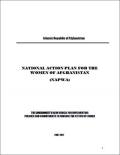
Resource | Publications,
Women constitute roughly 49% of Afghanistan's 23.3 million people. The development of women's human capital is strongly articulated in principle 5 of the Afghanistan Compact (AC) and highlighted as one of the 3 goals of gender equity in the Interim Afghanistan National Development Strategy (I-ANDS). The importance of this imperative cannot be overemphasized because women constitute an enormous reservoir of human resources that could significantly bolster the government's effort to rebuild the nation.
The current situation of women in the country presents a serious challenge to human development. The women of Afghanistan are among the worst off in the world, both in comparison to Afghan men and with women of most countries.
The advancement of women has always been central to our pursuit of national peace and reconstruction. From the Bonn Agreement to the Constitution, Afghanistan Compact and Interim Afghanistan National Development Strategy (I-ANDS), we have remained steadfast in our commitment to pursue gender equality and the empowerment of women in all spheres of life. As articulated in the I-ANDS, it is the goal of Government to eliminate discrimination against women, develop their human capital, and promote their leadership in order to guarantee their full and equal participation in all aspects of life.
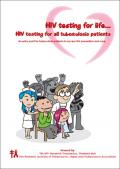
Resource | Publications,
This book is made for promoting every TB patient's access to HIV counseling and testing so that they can have equal access to HIV prevention and care which ultimately lead to reducing deaths and increasing survival of people infected by TB and HIV. It includes photos of HIV positive TB patients who have disclosed their HIV status to the public. Health staff can open the pages which contain photos and stories of these patients and show them to other patients. This may help to reduce self-stigma and may increase hope and strength for patients to accept HIV testing.
This book includes evidence from Thailand and other countries’ research which have been published in the international journals. Health staff may also use this evidence to convince the policymakers to recognize the importance of offering HIV counseling and testing for TB patients.
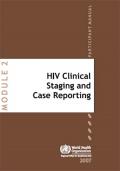
Resource | Tools,
The module is divided into seven units. The units are convenient blocks of material and should be studied in the order in which they are presented. In addition, there are several appendices at the end of the module. The last three appendices guide surveillance officers through the process of developing an action plan and operations manual for establishing and maintaining an HIV case-based surveillance system. Throughout the module, small group discussion questions are designed to assist in the development of the action plan and operations manual. The expected outcome from this module is an enhanced understanding of HIV case-based surveillance as well as a completed (or nearly complete) action plan and operations manual.
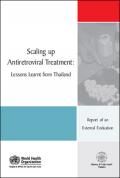
Resource | Publications,
This is the report of the third joint antiretroviral treatment (ART) programme review for Thailand since the programme started in 1992. Based on the recommendations of the first review held in 1995, the Ministry of Public Health (MOPH), Thailand started a pilot programme for the prevention of mother-to child transmission (PMTCT) of HIV in north-east and northern Thailand, along with the establishment of a HIV/AIDS clinical research network. This was followed, in 2000, by large-scale implementation of the national PMTCT programme in public hospitals. The second joint programme review, conducted in July 2000, recommended expansion of quality ART services to cover all government hospitals following the example of the national PMTCT programme.
This ART programme review was conducted from 12–19 October 2004 by a team of three national and 10 international experts, identified in consultation with the national authorities.





